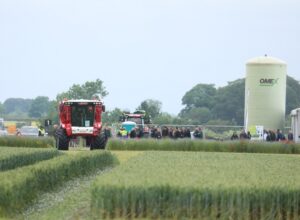 Arable farmers could maximise returns by including specialist crops in their rotations – and they can find out how at the Cereals Event 2017.
Arable farmers could maximise returns by including specialist crops in their rotations – and they can find out how at the Cereals Event 2017.
As pressure to diversify and increase profits mounts, this year’s Cereals event (14-15 June) will see the addition of the brand new Specialist Crop Zone. “We want to provide visitors with something a little extra this year,” says event marketing manager, Natalie Reed. “With high input prices and volatile grain prices, farmers’ margins are being squeezed. Crop diversification which provides added value but is still practical has never been more relevant.”
Nigel Padbury; seeds and marketing manager at Premium Crops, will be showcasing a variety of added value crops at this year’s event. “Specialist crops can really make a difference on farm,” he says. “Among our crops this year will be High Erucic Acid Rapeseed, which offers a £35/t premium over conventional rapeseed.”
As well as financial benefit, the inclusion of specialist crops in a rotation can also have agronomic advantages. “It’s important to look at the bigger challenges surrounding growing crops, such as pests and weeds,” explains Mr Padbury. “Linseed attracts attention due to its ability to tackle blackgrass as well as minimising slug levels – growers should re-think their rotations and use specialist crops to confront these issues.”
Rapid changes in the food industry, with consumers becoming increasingly health conscious, mean demand for specialist crops is rising. Quinoa has seen a huge increase in demand due to its nutritious properties – and it is a fantastic break crop, says Stephen Jones, director of the British Quinoa Company. “It’s a healthy, wholegrain product – deemed healthier than rice or couscous,” he explains. “It’s also gluten free, so we’ve seen demand for the crop soar.”
Dr Edward Dickin, crop production lecturer at Harper Adams University, will be exhibiting a forgotten crop; naked barley, which is set to shake the health food markets. While still at the experimental stage, Dr Dickin has been researching the benefits of this specialist crop. “The difference with naked barley is that the grain thrashes freely from the hull, making it look like wheat,” he says. “Not much barley is currently used in the food industry, but due to naked barley’s structure, the wholegrain can be used without processing. This makes it much more usable – we’ve currently got several food companies experimenting its inclusion in breakfast cereals.”
Most importantly, evidence shows naked barley carries the beta glucan soluble fibre known for controlling cholesterol and has a low glycemic index, meaning it can help with Type 2 diabetes.
Despite the misconception that specialist crops can be expensive, growing naked barley costs no more than conventional barley. Compared to wheat, it also needs less water during establishment and less nitrogen fertiliser. “There has been a recent trend for something a little bit different,” says Dr Dickin. “We’re really aiming to use Cereals as a chance to promote how beneficial crops like these can be.”
Other crops to be featured will include millet, borage and camelina alongside agronomic and marketing advice, says Ms Reed.




